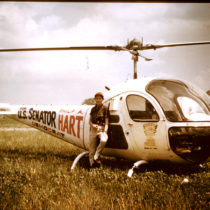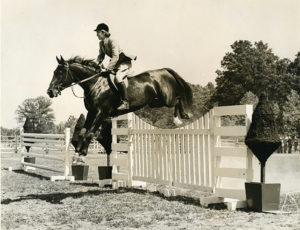Magazine

Nearly an Astronaut
From an early age, Jane Briggs Hart was fearless and fierce. As a senator’s wife, she bucked convention again and again, eventually using her love of flying to help pave the way for women in the NASA space program.
By Alex Boscolo
On a warm afternoon in 1957, Jane Briggs Hart was flying a helicopter over Michigan with her husband, Michigan Lieutenant Governor Phil Hart, beside her. He rehearsed his stump speech as she guided them over fields and forests, blades whirring, to their next campaign stop. It was a tight Senate race in 1958 and Jane, the first licensed female helicopter pilot in Michigan, wasn’t going to miss the chance to get her husband from place to place quickly in order to reach the most voters. That day, Jane dressed modestly for the warm weather, sporting Bermuda shorts, tall socks, and a long-sleeved shirt. When she landed the helicopter at the airport, a single photographer snapped a picture. That image ran in local papers, and the public was scandalized to see the Lieutenant Governor’s wife not only wearing shorts but piloting her husband around. This wasn’t a woman’s place, argued letters that were mailed to the couple.
Jane shrugged it off and continued doing whatever she pleased, which included campaigning for equal rights, raising eight children, competing in sailing races, hunting regularly, and flying back and forth to D.C. in her plane. Her collection at the Bentley reveals how her passion for flying was a thread that connected many parts of her life, and eventually landed her in front of a U.S. House committee, where she gave furious testimony about how women belonged in the NASA program. Her hard work for equality on all fronts would be the core of her work, right up to her death in 2015 at age 93.
From War to Politics
Jane was born in Detroit on October 21, 1921. As a young girl she was fearless, competing in elite horseback riding competitions, winning medals for coaxing her horses over the highest jumps. A 1941 news-paper article from the annual Devon Horse Show ran a photograph of Jane falling from her horse after just barely failing to clear a jump of four feet, six inches—a height that would land her in nearly the top level of U.S. competition, even today.

Jane and her horse Marina clear a jump at the Chevy Chase Horse Show in this undated photo.
Jane and her younger sister, Elizabeth, also grew up sailing, and they competed regularly in races on the Straits of Mackinac, a dangerous and often icy section of water just off Mackinac Island. She would complete the race 15 times with all-women teams.
When the U.S. entered World War II, Jane did her part by joining the Red Cross Motor Corps, driving trucks from Detroit’s auto plants to military bases and ports. After two years with the service, she earned her pilot’s license. She eventually would become well-known for piloting her own single-engine Bonanza, one of the first post-war commercial aircraft to include newly developed military technology.
When she was 22, she married a young military man and lawyer named Philip Hart. Their engagement was announced in all of the local papers; Jane kept a scrapbook dedicated to clippings about their engagement and wedding. Philip had liberal ideas and a drive for politics, which appealed to Jane as well.
In a 1950 newspaper clipping, carefully pressed in one of her many scrapbooks, Jane spoke of becoming “interested in the mechanics of government . . . following World War II,” and that she sought answers to a political climate rife with turmoil. That same year, she became vice chair of the Oakland County Democrats, and would regularly go door-to-door registering voters and encouraging participation. She firmly believed that the average person needed to be more involved in politics.
Doesn’t Care Beans
By the time Phil was elected to the Senate in 1958, Jane was the full-time caretaker of their eight children, while still regularly competing in aviation contests. Phil remained in Washington when Congress was in session, and Jane would fly her plane back and forth often. In a later interview, she remarked that she had to go to D.C. at least once a week to do Phil’s grocery shopping.
During this time, Jane enlisted and served as an officer in the Civil Air Patrol, and documented the accomplishments of other female pilots. If Jane lost a race, she carefully saved clippings about the winner.
Instead of relying on Phil’s platform, Jane found her own. She served as a founding member of the National Organization for Women (NOW), sat on the board of the League of Women Voters, and had a lifetime membership to the NAACP. Jane believed passionately in equal rights, and frequently spoke out against injustice. One newspaper article around this time headlined: “Mrs. Philip A. Hart doesn’t care beans about being a senator’s wife.”
Despite her civic engagement, she acknowledged that she didn’t have the patience for politics. In the 1960s, she limited her political responsibilities so that she could focus on a new passion: outer space.
The Mercury 13
On April 9, 1959, NASA announced that a group of seven astronauts would fly on the Mercury class of manned spacecraft. These were to be the first Americans in space, and they had to pass an extensive series of physical and mental tests in order to qualify. These original male astronauts were known as the Mercury 7.
NASA’s group only included men because women were not thought to be able to pilot rockets or withstand the rigors of space travel. However, some top executives at NASA were curious to see what effects space might have on the bodies of women. Further-more, they were able to obtain private funding from a famous female aviator named Jacqueline Cochran, who had an interest in furthering the careers of women pilots. Thirteen women eventually passed the same tests required of male astronauts, and they were informally called the “Mercury 13.”
Jane Briggs Hart was one of the pilots hand-selected by the organizers of the program to participate in the series of grueling tests. At the age of 41, she was the oldest candidate to pass them all. This included X-rays and routine physicals, but there were also more unusual challenges. For instance, women had to strap themselves to a tilt table to test their circulation, and their recovery time from vertigo was tested when doctors injected ice water into their ears.
By the end of 1961, Jane and the other 12 women were preparing to travel to Florida, where they had finally received government funding to undergo advanced examinations. Just a few days before, though, they received an abrupt telegram that their program had been canceled.
Jane was indignant. She had passed the same tests as the men and believed that she should have the same opportunity to be on the forefront of space exploration. In 1962, she and another woman, Jerrie Cobb, testified before a special House committee. The transcript, like so many newspaper clippings, is carefully preserved in one of her scrapbooks. When Jane spoke, she remarked that “it is inconceivable to me that the world of outer space should be restricted to men only, like some sort of stag club . . . I submit, Mr. Chairman, that a woman in space today is no more preposterous than a woman in a field hospital 100 years ago . . . I wonder if anyone has ever reflected on the great waste of talent resulting from the belated recognition of women’s ability to heal.”
Unfortunately, Jane’s well-reasoned appeal did not hold sway in Congress, and her program was not reinstated. This did not stop her. Well into the 1960s, she continued to lecture on the topic of women in space.
Clippings from her scrapbook at the Bentley note lectures she gave at the East Lansing Rotary Club and the Flint Golf Club on the “Space-Age Challenge for Women.” When the first female astronaut reached space in 1963, a Russian woman named Valentina Tereshkova, Jane wrote a scathing article in the New York Journal American that examined “attitudes toward the role of women in the space age [with the goal of making] whatever changes are necessary for women to fulfill that role.”
She remained an active proponent of civil and women’s rights for the rest of her life, through her husband’s career as a senator. When he passed away suddenly in 1976, The New York Times reported that President Ford called Jane to “ask if there was anything he could do.” She asked him to grant amnesty to all Vietnam draft evaders and deserters. Ford declined the request.
After Phil’s death, Jane continued to fly and sail regularly, while still supporting organizations such as NOW and the League of Women Voters. At age 73, she crewed a sailboat with her sister from Europe across the Atlantic to the Caribbean. Before her death in 2015, she donated her personal papers to the Bentley, which also holds Phil’s papers. Both collections are open to the public.
